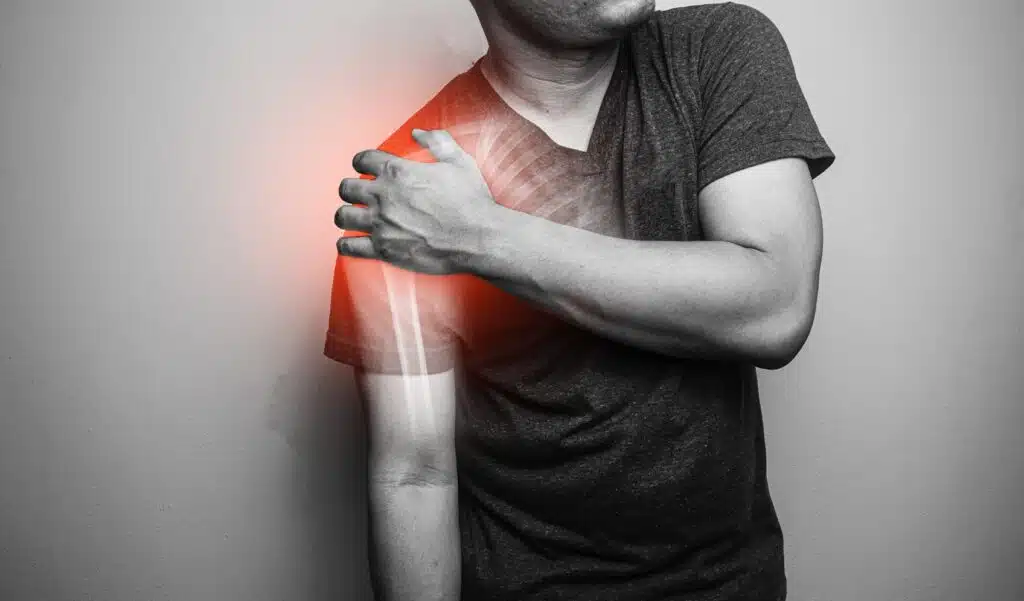This website uses cookies so that we can provide you with the best user experience possible. Cookie information is stored in your browser and performs functions such as recognising you when you return to our website and helping our team to understand which sections of the website you find most interesting and useful.



Shoulder fractures can involve different bones of the shoulder complex, including the clavicle (collarbone), the humerus (upper arm bone), and the scapula (shoulder blade).
Clavicle Fracture: A clavicle fracture is a break in the collarbone, which is located between the sternum (breastbone) and the shoulder blade. Clavicle fractures are relatively common and can occur due to direct trauma, such as a fall onto the shoulder or an impact to the collarbone. They are often associated with pain, swelling, bruising, and difficulty moving the arm.
Proximal Humerus Fracture: A proximal humerus fracture is a break in the upper portion of the humerus, near the shoulder joint. These fractures can vary in severity and may involve the humeral head (the ball of the shoulder joint) and/or the greater or lesser tuberosities (bony protrusions where muscles attach). Proximal humerus fractures can occur due to falls, direct blows, or trauma to the shoulder. Symptoms may include pain, swelling, bruising, and difficulty moving the shoulder.
Humeral Shaft Fracture: A humeral shaft fracture is a break in the middle portion of the humerus, between the proximal and distal ends. These fractures can occur due to direct trauma, such as a direct blow to the upper arm, or indirect trauma, such as a fall onto an outstretched arm. Humeral shaft fractures may cause pain, swelling, deformity, and difficulty moving the arm.
Scapula Fracture: A scapula fracture is a break in the shoulder blade, which is located on the back of the rib cage. Scapula fractures are relatively rare and can occur due to high-energy trauma, such as motor vehicle accidents or falls from height. Symptoms may include pain, swelling, bruising, and difficulty moving the shoulder and arm.
Acromioclavicular (AC) Joint Separation: While not technically a fracture, an AC joint separation involves damage to the ligaments that connect the acromion (a bony protrusion of the scapula) to the clavicle. This injury can occur due to a fall onto the shoulder or a direct blow to the AC joint. Symptoms may include pain, swelling, deformity, and tenderness over the AC joint.
please contact Dr. Stephen W. Pournaras.
Our professional medical staff can help you with your recovery.
The symptoms of a shoulder fracture can vary depending on the location, severity, and type of fracture.
Pain: is often the most prominent symptom of a shoulder fracture. It may be localized to the site of the fracture and range from mild to severe. It may worsen with movement or when pressure is applied to the affected area.
Swelling: around the shoulder is common following a fracture. The soft tissues surrounding the fracture site may become inflamed and swollen, contributing to pain and discomfort.
Bruising: or discoloration of the skin around the shoulder may occur as a result of bleeding into the surrounding tissues. The bruising may appear shortly after the injury and typically resolves over time.
Deformity: in some cases, particularly with displaced fractures, a visible deformity or abnormal shoulder alignment may be present. The shoulder may appear flattened, shortened, or misshapen compared to the uninjured side.
Tenderness: to the touch over the site of the fracture is common. The injured area may feel tender, sore, or painful when pressure is applied.
Difficulty Moving the Shoulder: depending on the fracture’s severity and location, shoulder joint movement may be limited or painful. Patients may have difficulty raising their arms, rotating the shoulder, or performing other shoulder movements.
Weakness: in the shoulder muscles may occur, particularly if the fracture impairs the normal function of the shoulder joint. Weakness may contribute to difficulty performing activities of daily living and may affect arm function.
Numbness or Tingling: in some cases, nerve involvement or compression associated with the fracture may cause numbness, tingling, or weakness in the arm or hand. This may indicate nerve damage and should be evaluated quickly.
It’s important to note that not all shoulder fractures cause noticeable symptoms, particularly in cases of hairline or nondisplaced fractures. Some patients may experience only mild discomfort or aching in the shoulder, which may be mistaken for a muscle strain or other soft tissue injury.
If you suspect a shoulder fracture or experience persistent pain, swelling, or difficulty moving your shoulder after an injury, it’s important to seek prompt evaluation and treatment by our medical team to prevent complications and promote the best healing and recovery.
Non-surgical treatments for shoulder fractures focus on managing pain, promoting healing, and restoring function to the shoulder . The specific treatment approach depends on factors such as the type, severity, and location of the fracture and the patient’s age, activity level, and overall health. or shoulder fractures:
Immobilization: Immobilizing the shoulder with a sling, brace, or splint is often the initial treatment for shoulder fractures. By stabilizing the fractured bones, immobilization helps reduce pain, prevent further injury, and promote healing. The immobilization duration depends on the fracture’s type and severity and typically ranges from a few weeks to several months.
Pain Management: Over-the-counter pain medications, such as acetaminophen (Tylenol) or nonsteroidal anti-inflammatory drugs (NSAIDs) like ibuprofen (Advil, Motrin) or naproxen (Aleve), may be recommended to help relieve pain and inflammation associated with the fracture. Prescription pain medications may be necessary for severe pain.
Rest and Activity Modification: Resting the affected shoulder and avoiding activities that exacerbate pain or stress on the fractured bones is essential for promoting healing and preventing complications. Patients may need to modify their daily activities, work tasks, and recreational pursuits to avoid putting undue strain on the injured shoulder.
Physical Therapy: Once the acute pain and inflammation subside, physical therapy exercises may be prescribed to help restore strength, range of motion, and function to the shoulder joint. Physical therapy can also help prevent stiffness, muscle weakness, and joint instability associated with prolonged immobilization.
Ice Therapy: Applying ice packs to the injured shoulder can help reduce pain, swelling, and inflammation. Ice therapy should be applied for 15-20 minutes at a time, several times a day, especially during the early stages of healing.
Follow-up Monitoring: Regular follow-up visits are important to monitor the healing progress, evaluate pain and function, and make any necessary adjustments to the treatment plan. X-rays or other imaging studies may be performed periodically to assess bone healing and alignment.
Avoidance of Smoking and Alcohol: Smoking and excessive alcohol consumption can impair bone healing and delay recovery from a fracture. Patients are advised to avoid smoking and limit alcohol intake during the healing process to optimize outcomes.
There are several surgical options based on the type and severity of your shoulder fracture and your overall health. Dr. Stephen W. Pournaras Jr. will discuss your options and help you decide which is best for you.
Surgical options for shoulder fractures depend on various factors such as the type, location, and severity of the fracture, as well as the patient’s age, activity level, and overall health.
Surgery is recommended when non-surgical treatments fail to manage symptoms adequately or when there is a risk of complications such as displacement, nonunion, or malunion of the fractured bones.
Open Reduction and Internal Fixation (ORIF): is a surgical procedure used to realign the fractured bones and stabilize them using internal fixation devices such as plates, screws, pins, or wires.
This procedure is typically performed through a larger incision, allowing Dr. Pournaras direct access to the fractured bones to realign them into the correct position and secure them with hardware.
ORIF is commonly used for complex or displaced fractures of the proximal humerus, scapula, clavicle, and certain types of humeral shaft fractures.
Closed Reduction and Percutaneous Pinning are minimally invasive procedures in which the fractured bones are realigned without a large incision. This is often done under fluoroscopic guidance in the operating room.
Percutaneous pinning involves inserting metal pins or wires through the skin and into the fractured bones to hold them in place while they heal.
This technique is used for certain types of proximal humerus fractures or clavicle fractures that are amenable to percutaneous fixation.
External Fixation: involves placing metal pins or screws into the fractured bones and connecting them to an external frame or device outside the body to stabilize the fracture.
This technique is typically used for complex or severely comminuted fractures, open fractures, or fractures with soft tissue injury or contamination.
External fixation may be temporary, serving as a bridge to definitive internal fixation or allowing for gradual deformity correction.
Bone Grafting or Augmentation: in cases of significant bone loss or comminution, bone grafting or augmentation may be necessary to promote bone healing and restore stability to the fracture site.
Bone grafts may be obtained from the patient’s own bone (autograft), allograft (donor bone), or synthetic bone substitutes.
Arthroplasty or Joint Replacement: in some cases of severe or irreparable shoulder fractures, particularly in older patients with osteoporosis or arthritis, shoulder arthroplasty or joint replacement may be necessary.
This involves removing the damaged or fractured portions of the shoulder joint and replacing them with prosthetic components to restore function and alleviate pain.
Revision Surgery: in cases of failed or suboptimal outcomes following initial surgical treatment, revision surgery may be necessary to address complications such as malunion, nonunion, hardware failure, or recurrent instability.
Make Your Appointment Today
Fair Oaks Ortho – Fairfax,VA


